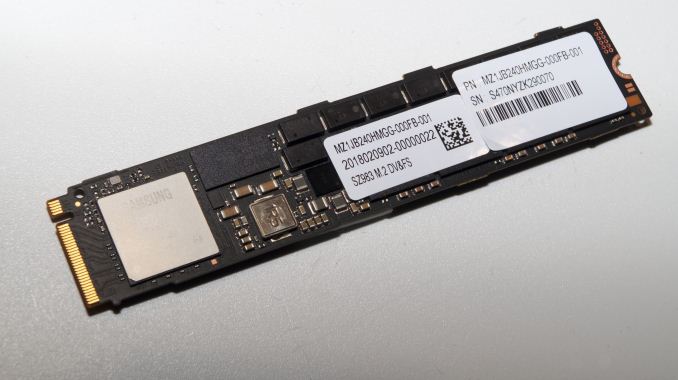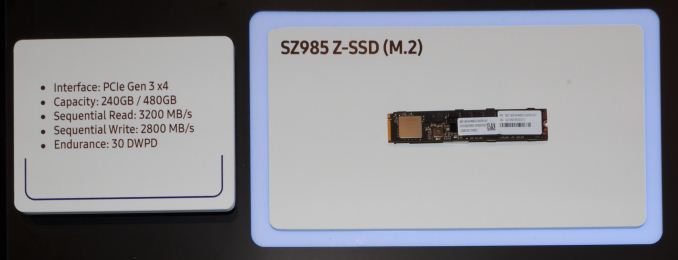Samsung Reveals M.2 Z-SSD
by Billy Tallis on March 27, 2018 8:15 AM EST
Last week at the Open Compute Project (OCP) Summit in San Jose, Samsung's booth included a surprise appearance of a Z-SSD in the M.2 form factor. Samsung has been pitching their Z-SSD SZ985 using Z-NAND memory as a low-latency competitor to Intel's 3D XPoint-based Optane SSDs. The Z-SSD SZ985 has made many trade show appearances over the course of its development, but always in the form of a half-height half-length PCIe add-in card.
That card keeps all the interesting components covered by a heatsink, leaving us with little indication of the PCB's layout, but some of Samsung's earlier presentations included renderings showing a very large SSD controller, similar in size to a typical 16-channel controller. Samsung's exhibit at the OCP Summit included a M.2 version of the SZ985, revealing that the controller is in fact the same Phoenix 8-channel controller used on Samsung's other 98x SSDs, including the PM981 client SSD. This controller is also very likely to be used in Samsung's next generation consumer retail NVMe SSDs, the successors to the 960 PRO and 960 EVO.
Samsung's exhibit called the drive the SZ985 Z-SSD, but the stickers on the drive say SZ983. The capacity of the demo unit appears to be 240GB, the same as the smaller capacity announced earlier this year when the Z-SSD SZ985 officially launched. Samsung's display also listed a 480GB capacity, likely the most first-generation Z-NAND that Samsung can fit onto the M.2 card.
The development of a M.2 Z-SSD raises the possibility of Samsung introducing a Z-SSD for the enthusiast consumer market, to compete against the Intel Optane SSD 800P. However, it is likely that Samsung can remain quite competitive in the high-end consumer SSD space with another conventional MLC-based SSD to replace the 960 PRO. Sacrificing further capacity for incremental performance gains would probably not be worthwhile, even though a Z-SSD doesn't go as far down that road as Optane SSDs.
Source: Samsung













37 Comments
View All Comments
UnemployedMerchant - Tuesday, March 27, 2018 - link
That much on Intel ??? They havent fixed it yet?ZeDestructor - Tuesday, March 27, 2018 - link
Anandtech looked into it a few days ago. They confirmed that real-world performance was closer to around 3%. The 30% number basically only shows up in syscall benchmark situations. The rest of the time, your CPU just ends up showing slightly higher CPU usage (oh no... CPU usage went from 5% to 7%) with practically no performance degradation.ಬುಲ್ವಿಂಕಲ್ ಜೆ ಮೂಸ್ - Tuesday, March 27, 2018 - link
What I do not want is a 5 year warranty on these thingsBefore the 860 Pro was released, we were getting the 850 Pro (256GB) for around $120 @ Newegg
Today, all you can get is a refurbished 850 Pro without a decent warranty for $145
A new 850 Pro can still be bought in the Newegg marketplace for $175
A new 860 Pro is $140 but only has a 5 year warranty
The specs on the 860 Pro do not suggest a noticeable speed difference over the 850 Pro yet they are claiming much improved reliability?
Really?
If it is more reliable, then why was the warranty dropped from 10 years to 5?
I would think that higher reliability would get us a better warranty since the speed difference is all but non-existent and irrelevant
When we can now get power supplies with a 12 year warranty, I would like to think I could guarantee my data for the same period of time
Back up those reliability claims with a warranty to match Samsung!
I'm tired of paying more for less
MrSpadge - Wednesday, March 28, 2018 - link
> I would like to think I could guarantee my data for the same period of timeAn attractive thought for sure, but the warrenty is not going to protect your data in the event of a drive failure.
Alexvrb - Tuesday, March 27, 2018 - link
I want faster. I'd probably consider a 240GB if the price was right, for the OS drive. I'd install everything else on a larger, somewhat slower secondary M.2 drive.evancox10 - Tuesday, March 27, 2018 - link
An explanation of what a "Z-SSD" is would helpjordanclock - Tuesday, March 27, 2018 - link
From the article:"Samsung has been pitching their Z-SSD SZ985 using Z-NAND memory as a low-latency competitor to Intel's 3D XPoint-based Optane SSDs."
It's a new design for NAND for even better performance than what is currently in widespread use.
CheapSushi - Tuesday, March 27, 2018 - link
It's basically NAND (MLC or TLC) that's treated like SLC because of the inherent performance, latency and endurance benefit. SLC is 1 bit per cell. MLC is 2 bits per cell, TLC is 3 bits per cell and QLC is 4 bits per cell (it's a hierarchy from $$$ to $, etc). SLC was always extremely expensive in comparison. So it gets closer to Optane but a bit cheaper. Optane using phase change tech rather than traditional NAND to get it's inherent benefits, so costs more.eddieobscurant - Tuesday, March 27, 2018 - link
first gen z-nand is actually real SLC. The 2nd gen will be mlc. Samsung already have mentioned that on their slidesSantoval - Friday, March 30, 2018 - link
I have not seen those slides but if they have really mentioned that I suppose "real SLC" is a hell of a lot sexier (from both a marketing perspective and in general) than "pseudo-SLC". More likely you do not recall correctly and it was rather "the first gen of Z-NAND will be treated as SLC, while the second one will be treated as MLC". That neatly avoids both the "pseudo-" and the (fake) "real" part ;)